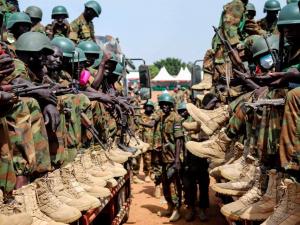
Military interventions have failed to end DRC’s conflict – what’s gone wrong
The Congolese state’s inability to guarantee security has created fertile ground for armed groups to emerge. Aside from violence, they engage in various illicit activities, like exploiting mineral riches.
Weakened by decades of kleptocratic rule and armed uprisings, the Congolese state relies on support from regional and global actors. The United Nations peacekeeping and stabilisation mission has been in the DRC for more than 20 years. In February 2023, the UN force (Monusco) had 16,316 men and women from 62 countries operating as intervention troops, staff officers and mission experts.
The East African Community (EAC) completed its deployment of troops in April 2023. No sooner had they settled down than the DRC asked the Southern African Development Community to “restore peace and security in eastern DRC”.
More than a decade of research on identity politics, indigeneity, human rights, transitional justice and peacebuilding in the region informs my view on its prospects for peace. This revolving door of military interventions raises questions about whether domestic and international actors involved genuinely examine past failures and draw useful lessons from them. Contemporary crises often re-emerge from unresolved prior crises. This is the case here.
I argue that the DRC is being short-sighted, driven by populist pressures and political calculations. It’s making the M23 rebel movement the single convenient target of its actions, instead of resolving its deeper and broader problems.
Disrupting the peacekeepers
Many of the issues that the DRC government and other regional actors have undertaken to address are well known and documented. The UN Peacemaker database lists 19 agreements concluded since the Sirte Agreement of 1999. This preceded negotiation to end the second Congo war in 2003.
The DRC has committed to guarantee security for different communities, to resolve identity, citizenship and land issues, to oversee the return of refugees, and to a demobilisation process that addresses the concerns of belligerents.
The East African Community force’s mandate was formulated with this in mind. The force would, in collaboration with Congolese military and administrative authorities, stabilise and secure the peace in DRC. The initial deployment of Kenyan, Burundian, Ugandan and South Sudanese troops was projected to grow to between 6,500 and 12,000 soldiers in eastern DRC.
The idea was to reduce tensions by enforcing a ceasefire and a withdrawal of armed groups to initial positions. Local armed groups would be demobilised in an orderly way through a political process involving talks with Congolese authorities. Finally, foreign armed groups would be repatriated.
What came to be known as the Nairobi process framed the resolution of the M23 crisis within a broader goal of peace-making. All domestic and regional armed groups active in eastern DRC would be disarmed and the emphasis was on dialogue.
Before long, it went wrong. DR Congo president Felix Tshisekedi bluntly criticised the EAC force and suggested that it might be asked to leave.
It seems that a comprehensive peace strategy is not an immediate priority for Congolese authorities. They have an eye on elections. These are planned for December 2023, and the current president is seeking a second term. Tshisekedi’s administration has turned the fight against the M23 and its alleged backers into a tool of popular mobilisation in support of its policies. Therefore, military and diplomatic success on this front remains its priority.
Towards sustainable peace
Authorities in the DRC have also announced that UN peacekeepers in the country would be withdrawn by December 2023.
Congolese authorities have criticised the East African force and the UN mission for their unwillingness to fight the M23. The M23 is seen as representing nothing more than a masked Rwandan (and at times Ugandan) intervention in the DRC, and as such the biggest threat to Congolese territorial integrity.
The DRC’s counter strategy is to recognise some local armed groups as resistant patriots (Wazalendo) to be officially supported in fighting an external aggression. Several public officials are on record expressing their support for these Mai Mai-Wazalendo fighters.
None of the triggers of the DRC’s recurrent crises can be addressed in this atmosphere. It’s impossible to imagine scenarios where sustainable peace can be achieved without first addressing land rights, equal citizenship claims and inclusive governance institutions catering to the needs of the entire Congolese population.
Enforcement of a comprehensive strategy that addresses belligerence and the disarmament of all armed groups through a combined military and political dialogue strategy, as imagined under the Nairobi process, should be the main priority of any peace initiative. Peace between peoples and countries in the region requires a genuine commitment to addressing all local, regional and international dimensions of the crises in eastern DRC.
Authored by Felix Mukwiza Ndahinda - Honorary Associate Professor, College of Arts and Social Sciences, University of Rwanda.
